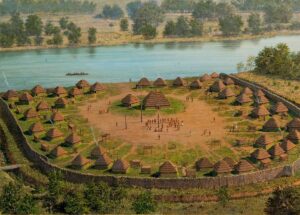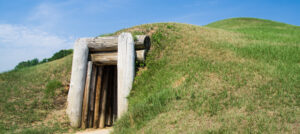
The Ocmulgee Mounds is a very large Native American settlement, located on the East bank of the Ocmulgee river, near Macon, Georgia. The settlement is one of the oldest continually inhabited areas in North America. Artifacts have been discovered dating as far back as 15,000 BCE, where it was inhabited by Paleoindian ice age hunters, up through modern times, with the most recent indigenous inhabitants being the Muscogee Creek tribe.
The central civilization, having done the vast majority of construction and landscape alteration, were the South Appalachian Mississippian culture, a regional variation of the expansive Mississippian culture. They built many major earthworks, including the Great Temple, burial mounds, ceremonial mounds, and defensive trenches. One of the most visited of these earthworks is the Earth Lodge, consisting of a large mound with a council chamber inside. The original clay floor is still in place and has been carbon dated to its original construction in the year 1015.
The Ocmulgee Mounds is also the site of the largest archeological effort in American history. Between the years 1933 and 1936, over 800 people, led by Smithsonian archeologist Arthur Kelly, excavated over 2 million artifacts from the mounds and surrounding area, which helped piece together the rich history of flourishing society, trade and recreation. They discovered many important cues as to what life was like in the Mississippian city, including a large marketplace with artifacts from across the country and vast, systematic farmland where corn and other crops were grown in the floodplains south of the city.
Sources and further reading:
National Parks Service: https://www.nps.gov/ocmu/index.htm
National Park Foundation: https://www.nationalparks.org/connect/blog/ocmulgee-national-monument-attraction-prehistoric-proportions-macon-georgia
